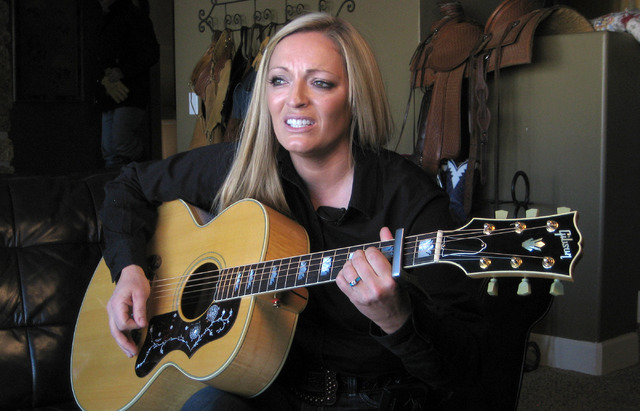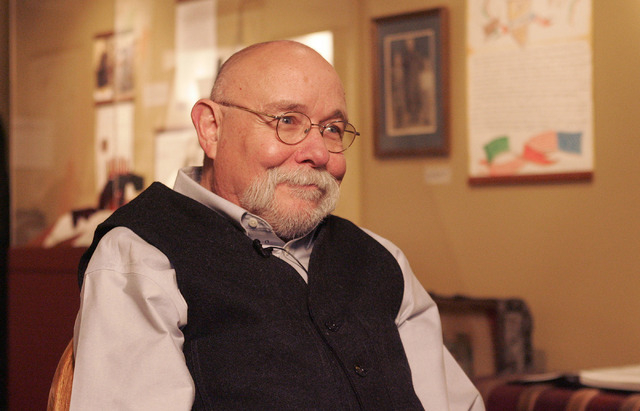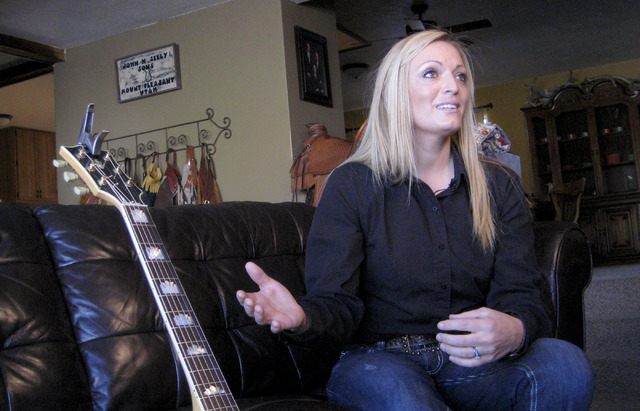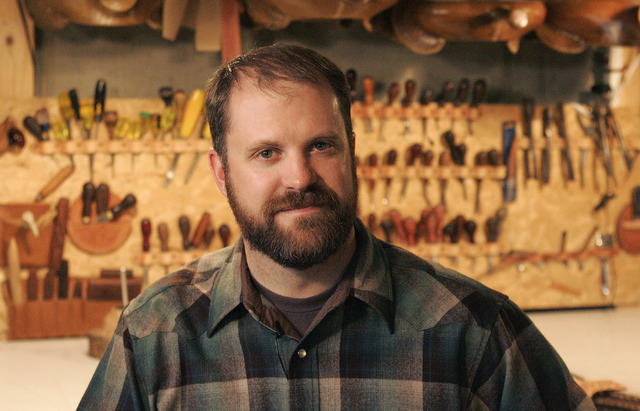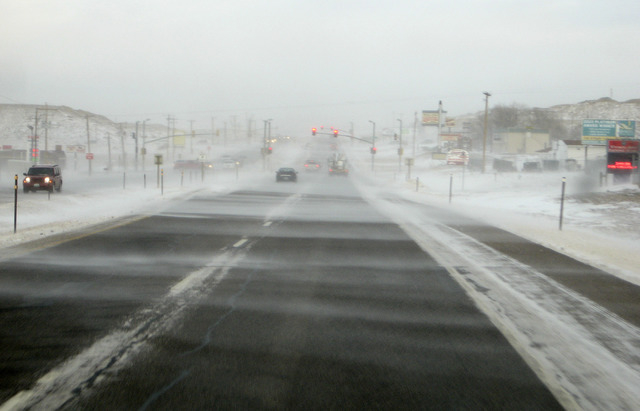Cowboys from Nevada and beyond blaze trails through poetry, song and art
Editor’s Note: Nevada 150 is a yearlong series highlighting the people, places and things that make up the history of the state.
The Wyoming wind that whips snow into a blinding ground blizzard makes the range around the small town of Encampment as lonely and barren as a North Atlantic iceberg.
When temperatures drop below zero, coyotes burrow deeper, pale green sagebrush gets buried in drifts and wind strong enough to slice through a half-dozen layers of clothing guarantees there won’t be any locals lingering outside the Trading Post, the town’s one-stop-shop for gasoline, groceries, work gloves and even snowshoes.
But Daron Little knows better than to call the desolate expanse of the Cowboy State lifeless.
Little, a cowboy on the Silver Spur Ranch, resents it when outsiders overlook the life he sees every day.
“The one cliche that my wife can attest to that makes me mad is ‘the dying breed,’ ” Little, 44, said. “There are so many guys out here starving to death, families trying to make a living to feed the world. It is just ridiculous.”
But unlike most, the lifelong artist, singer and writer can express his feelings about cowboy life through song.
A Louisiana native, Little came out West to cowboy during summers in college, taking photographs and painting along the way. He remembers picking up a cassette of the iconic cowboy music album “Cowboyography” by Ian Tyson because he liked the cover photo.
“It had this cool picture of this cowboy and, having been out here, I could tell this dude has been out and around. He is not a store-bought, drugstore kind of guy,” Little said. “I put that in … and I just listened to it to death. I understood it.”
Eventually, Little quit his job as a graphic artist. He and his wife, Dana, moved west with their daughter for a full-time cowboy life.
That combination of love for life in the rural West and artistic sensibility is what will compel Little, and thousands of others, to trek to Elko for the 30th National Cowboy Poetry Gathering, which starts Monday. Little isn’t an invited performer, but he plans to show up, guitar in hand, to soak up the experience.
“Everybody just wants to go there for the heritage of it,” said Little, who plans an informal jam session at the Star, a Basque restaurant a few blocks from the Western Folklife Center, which hosts the gathering. “That’s my crowd, the ranch-rodeo guys. If anybody gets what I do, they do.”
DYING BREED
That the 30-year-old gathering still pulls contemporary artists and cowboys to Elko each winter shows its importance in Western culture. The power of the event has been evident since 1985, when organizers hoped to revive what they feared was a dying art form.
They wanted to tap into a Western tradition, an art form developed in the 19th century, when cowboys adapted song and storytelling styles with roots in the British Isles and popular poetry to fit their lives. Cowboy poetry also came to reflect the style of Mexican vaqueros influenced by the traditions of horsemen in Spain and North Africa, according to Westminster College folklorist David Stanley, who wrote a history of the art form.
The advent of cowboy movies in the 1920s overshadowed traditional culture, when the rough folkways of the West were sanitized for the screen by Roy Rogers, Gene Autry and other singing cowboys. By the early 1980s, the culture of real-life working cowboys had been virtually erased from public consciousness. Even rarer was awareness of their original art.
“We knew there were still some of these guys who were reciting poetry, but it was a tradition that was pretty much dormant,” said Charlie Seemann, executive director of the Western Folklife Center in Elko, which organizes the poetry gathering.
Seemann, who has been with the center since the beginning, only missing the first gathering, said organizers thought they were being optimistic on that cold night in January 1985 when they set up five dozen chairs in the Elko Convention Center.
About 1,000 people showed up, with an estimated 90 percent coming straight from ranches. No one was more surprised by the turnout than the poets.
“These guys were not performers,” Seemann said. “They would get up onstage, and their knees were knocking and they were scared to death.”
The gathering attracts thousands to see more than 50 invited singer-songwriters, musicians and poets and to attend a gear show, workshops and panel discussions in eight venues over the course of a week. The Elko gathering is thought to have spawned hundreds of imitators across the United States and Canada.
In addition to official performances, the event spills into Elko’s bars and restaurants, where performers sing, drink and swap stories with each other, their audience and whoever shows up.
As always, the performances spring from experiences of working cowboys, ranchers and rural Westerners.
“We don’t want it to become a parody of itself,” Seemann said. “Most of the poets and musicians who perform here come out of the culture. They have been working cowboys — they are working cowboys.”
That connection to ranch life, Seemann said, keeps the gathering vibrant.
“I can tell you cowboys, probably more than any other group of people you will ever find, are adamant about authenticity,” he said. “They are sticklers. Some guy has a spur on upside-down — anything that is fake, that is not real … they will pick up on it immediately.”
And authenticity sells. Although Seemann said overall attendance is hard to track because individual performances are ticketed separately, revenue from the gathering surged from about $200,000 in 1996 to $1.2 million in 2009. During the Great Recession it fell, bottoming out around $700,000 in 2011, before recovering to nearly $800,000 last year.
That’s because the gathering, which in 2000 was recognized by the U.S. Senate as the National Cowboy Poetry Gathering, has become the top destination for people who want to experience cowboy culture firsthand.
“In terms of the audience, early on it was all ranching folks,” Seemann said. “I would say now a big part of the audience is people who are interested in the West and Western culture but are not from the culture. They may be from L.A. or they may be from Salt Lake City or wherever.”
But if the gathering is going to retain that authenticity, and success, for another 30 years, it will need to tap into a new breed of cow culture talent.
WORKING TOWARD FUTURE
Many of the original performers and audience members are gone or in their waning days. This year, longtime cowboy poet Wallace McRae will miss the event for the first time. He’s busy fighting a coal-hauling rail line near his Montana ranch.
John Dofflemyer, another longtime poet, will also miss the gathering. Drought threatens his ranch near Visalia, Calif.
Poet Paul Zarzyski said he’s already seeing waning crowds at smaller events around the West. He added that the audience at Elko isn’t getting any younger.
“You can almost look out and say, ‘That’s where Bruce and Linda sat, but they are not sitting there,’ ” he said. “Why isn’t someone else sitting there in their place?”
Zarzyski’s observation isn’t taken lightly by Seemann and others involved. With the event beginning to recover from the recession, organizers are building for the future.
That means inviting younger performers, recrafting popular programs such as the gear show and reaching out to younger people interested in all forms of poetry and art, even if that isn’t strictly the cowboy way.
Zarzyski and other poets work with high school students in Elko and elsewhere on literary programs such as Poetry Out Loud, a national competition that encourages young people to learn through memorization and recitation.
Emily Nielson, an English, speech and journalism teacher at Elko High School, said access to the gathering and its performers helps local students from all backgrounds gain appreciation for poetry.
“Cowboy poetry is still human poetry,” Nielson said. “You don’t have to live on a ranch, you don’t have to have that background to still appreciate it.”
The event also has updated workshops to help ranch people sell and promote their art through the Internet and social media. This year the Western Folklife Center hosted an online video contest in which people ages 18 to 35 could submit recordings of original poetry. The winner gets a performance slot at the gathering.
“Tradition changes over time,” Seemann said, ”you can’t petrify it in one place, otherwise it dies.”
BREAKING STEREOTYPES
Among the younger invitees is singer-songwriter Trinity Seely of Alcova, Wyo.
Seely, 32, lives with her husband, Jeff, and their four children on a ranch near the Sweetwater River south of Casper.
At her first gathering, she’ll play songs from her two Western albums that are largely about her life on the ranch.
What makes her songs different from much of the material on the circuit is her point of view.
She sings about life as a wife, mother and rancher whose work is much the same as that of her husband, a full-time cowboy.
“A lot of people use the term ‘cowgirl,’ ” she said. “There are a lot of things we do that the cowboys do, so ‘cowboy girl.’ ”
Seely is especially proud of “Kitchen Window Cowboy,” a song about feeling stuck in the house with young children and domestic responsibilities when she wants to be out working the ranch.
“That’s not something you can really make up unless you are feeling it,” she said.
Another song, “Cowgirl Spirit,” is about ranch women doing what once was considered “men’s work.”
“It talks about these girls (who) know how to go out there and work hard,” Seely said. “I think people find it intriguing that when my husband needs help, he doesn’t go get some other man, he comes and gets his wife.”
Jeff Seely, who isn’t a musician, considers himself a traditionalist who thinks a lot about the pioneers who lived, bled and died in the valley where his family lives and works.
But traditional is different than cliche, and when it comes to culture, he says authenticity is more important than re-enforcing cowboy stereotypes.
“It doesn’t matter if he has a big old handlebar moustache or not,” he said. “If they are sincere and they are authentic we can tell.”
His wife’s music meets the standard by reflecting reality that television, movies and pop culture rarely explore.
“I can’t talk well, I can’t write well, I don’t express myself well and I’ve talked to a lot of working cowboys who feel the same,” he said. “We count on people like Trinity to express our feelings for us.”
And don’t make the mistake of thinking that cowboy music is the same as country-western.
“Those guys wear hats, too, but they may not have earned them the same way,” Seemann said.
MODERN WAYS VS TRADITIONAL
The headliners have always been poets, singers and writers, but the organizers emphasize a wider mix of Western arts. “Expressing the Rural West — Into the Future” is a fresh take on the gathering’s gear exhibits featuring saddlemaking, leather work and silversmithing. For the first time, the show will focus on work by makers who are 40 and younger.
Andy Stevens, 37, an Elko-based saddlemaker, silversmith and cowboy, is curator.
Stevens, who learned saddlemaking through a traditional schooling and apprenticeship path, said there is new interest in Western handicrafts.
“Because of the Internet, they can see what other people are doing, they can meld several different ideas into their own,” Stevens said.
And talented artists have a quicker path to financial viability, Stevens said.
“When I started, I did a lot of trade shows. I gave a lot of stuff away to different organizations. I spent a lot of money promoting myself,” Stevens said. “Nowadays with social media, you can throw a picture up there and it can hit the masses pretty easy.”
But as with poetry, the gear show is aimed at those rooted in ranch life.
The difference, Stevens said, is that gear made by people who work with animals is better than anything made for a show or mass produced.
In his basement workshop, Stevens shapes saddles that can take dozens of hours to cut, carve and finish. Most are used in everyday work.
Stevens said time in a saddle is crucial because it helps a saddlemaker understand what’s needed. By watching a cowboy’s dallie — the way he uses a rope — an experienced craftsman would know how to customize a saddle horn for the best fit.
And a cowboy knows the value of rugged dependability over fashion and flash.
“If it fails, it can be a helluva wreck,” Stevens said. “It could be a serious injury or, you know, a guy could get killed.”
RENEWED OPTIMISM
That same attention to authenticity and honesty in poetry and song means success or failure for the gathering. And in many ways, it’s the glue that holds together the scattered and often battered Western lifestyle.
Ranches and the people who work on them are facing existential threats in the form of rampant mineral and petroleum development, drought, climate change, corporatization of beef production, and taxes and regulations that make it hard for families to hand ranches down to the next generations.
Fewer than 30,000 people work in an occupation that includes some form of cowboy duty, according to the U.S. Bureau of Labor Statistics. And the average annual pay for such work is about $32,000.
Even the people who own land or raise a family on a ranch struggle to hang on to the lifestyle.
Zarzyski points to McRae’s poem, “Things of Intrinsic Worth,” as an example of a cowboy using art to defend his way of life.
“(McRae) was in a battle against coal production in his country and how that was affecting grass and water,” Zarzyski said. “He is one of my heroes … because of his willingness to take a stand and write about that.”
Dofflemyer has used poetry to explore everything from drought to the toll of the Vietnam War, the latter subject featured in “Blood Trails,” a collection of poems by veterans he edited and published in 1993.
“I think it is kind of a waste of time to write to a politician,” Dofflemyer said. “I like to kind of deal with the stuff as honestly as I can.”
The gathering provides a safe place for people to express points of view seldom associated with rural Westerners, such as McRae’s environmentalism and Dofflemyer’s criticism of a war.
“I think a lot of the work we have done has helped shape the way the West is evolving,” Seemann said. “We have managed to have conversations here, sort of on neutral turf during the gathering, that you couldn’t have anywhere else.”
Kent Reeves, an environmental consultant and cowboy who packs horses in the Sierra Nevada, witnesses the effectiveness of poetry and song in his everyday life.
“I use poetry when I give professional papers,” Reeves said. “The way (scientists) talk about it is so mundane and boring, they lose their audience.”
Reeves uses his education and ranching experience to create poetry conveying important messages about conservation. Among the most significant is that ranchers and cowboys are crucial to preserving the landscape because they know how it works and suffer the consequences of any damage.
“The main thing isn’t getting people to talk, it is getting them to listen,” Reeves said. “You don’t have to give up what it is you believe in most in order to have a healthy land, healthy profits and a healthy family life.”
Zarzyski, the poet who’s noticed Western audiences aging and drifting away, goes from worrying about waning interest to feeling a restored optimism in the future after each gathering.
The optimism, he said, comes from the eclectic mix of city and country people who attend and the authentic experience they enjoy.
“I think that Elko has given people who didn’t feel that they were worthy, who didn’t feel they were worthy of telling their own stories, it has given them license to do so,” Zarzyski said. “I have never once left that gathering without embracing a greater hope for our so-called civilization.”
Little, who intends to keep trying for an invitation to perform, is also hopeful about the future of the genre — as long as the artists remain honest.
“You have to have guys that are out here and gals who are out here and (who) understand the trials and tribulations that ranching and cowboy culture is going through right now, to be able to write that into song and present it in a way that people will want to listen to it.”
Contact reporter Benjamin Spillman at bspillman@reviewjournal.com or 702-383-0285. Follow him on Twitter @BenSpillman702.
Cowboy poetry highlight: Poet Waddie Mitchell of Elko, Nev., will debut a new poem titled "The Dame Nevada" on Monday, Jan. 27 at 7 p.m. at the Western Folklife Center’s G3 Bar Theater. Tickets for the event are $20. Mitchell is the honorary poet for Nevada’s 150th anniversary celebrations.



